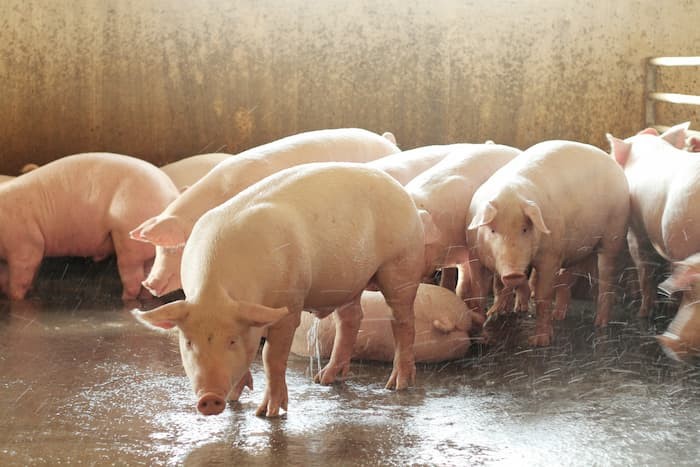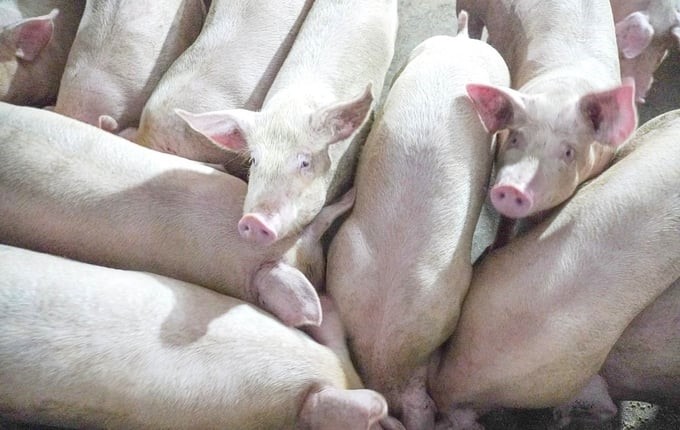In pig farming, diseases are the main cause of reduced productivity and serious economic losses. Among them, swine paratyphoid is one of the most dangerous infectious diseases, often breaking out rapidly and being difficult to control.
During pig production, many farmers have experienced prolonged diarrhea, high fever, anorexia, and mass mortality in their herds, especially in post-weaning piglets. These symptoms are often mistaken for classical swine fever or pasteurellosis; however, in reality, they may indicate swine paratyphoid – a highly contagious disease that can cause severe damage to pig herds if not detected and treated promptly.
1. CAUSE
Swine paratyphoid is caused by Salmonella spp., primarily Salmonella choleraesuis and Salmonella typhimurium. These bacteria are highly resistant, capable of surviving for months in moist environments, and can persist for long periods in feces, soil, and water.
Major sources of infection include:
– Infected pigs and carriers shedding bacteria into the environment.
– Contaminated feed and drinking water.
– Poor hygiene and damp housing conditions.
The bacteria are mainly transmitted via the digestive tract. Once ingested, they cause septicemia, damaging the liver, spleen, and intestines, leading to severe diarrhea.

2. CLINICAL SIGNS
The disease is most common in piglets aged 20 days to 3 months. Depending on the infection level and immune status, it can occur in two forms:
Acute form (common in post-weaning piglets):
– High fever (41.5–42°C).
– Anorexia, depression, huddling, shivering.
– Severe diarrhea with grayish-green feces, sometimes containing blood, with foul odor.
– Some pigs show nervous signs: ataxia, tremors, convulsions.
– Without treatment, death occurs within 3–5 days.
Chronic form (common in fattening pigs and sows):
– Initially constipation with black, mucoid feces; after 1–3 days, foul-smelling yellow watery diarrhea with intestinal mucosal debris; vomiting may occur.
– Rapid weight loss, growth retardation.
– Necrotic, cyanotic patches on the abdomen, ears, and thighs.
– Progressive weakness, death may occur after several weeks.

3. PATHOLOGICAL LESIONS
Post-mortem examination of pigs that die from paratyphoid commonly reveals:
– Enlarged, firm spleen.
– Liver with multiple grayish-white necrotic foci.
– Severe enteritis with ulceration and hemorrhage in the small intestine and cecum.
– Swollen, edematous lymph nodes.
– Congested and hemorrhagic lungs.
4. TREATMENT
Specific antibiotic therapy against Salmonella:
Administer one of the following antibiotics by injection for 3–5 days: Amoxicillin, Florfenicol, or Enrofloxacin, include BIOCILLIN 150 LA, FLONINE LA, INTERFLOX 100.
Supportive treatment:
– Antipyretics and analgesics: e.g., ANAGIN 500 INJ for rapid fever reduction. Tonic agents: e.g., BUTASAL 100 to improve recovery.
– Electrolyte supplementation to correct dehydration and electrolyte imbalance: e.g., COOLVIT Probiotics and digestive enzymes to restore gut function: e.g., HASPRO.

5. PREVENTION
As with all animal diseases, “prevention is better than cure.” With swine paratyphoid, this principle is particularly important since outbreaks often cause mass mortality.
Effective preventive measures include:
– Maintaining dry, clean housing; regular disinfection.
– Ensuring feed and water are clean, free from mold and contamination.
– Proper manure and wastewater management to limit spread.
– Applying “all-in, all-out” production systems with adequate downtime for facilities.
– Vaccination: currently available vaccines should be administered to post-weaning piglets and sows.
– Enhancing resistance: supplementing vitamins, probiotics, and minimizing stress during weaning, relocation, or dietary changes.
Swine paratyphoid not only causes sudden death but also leads to stunted growth and poor development, resulting in heavy economic losses. The most crucial strategy is proactive prevention, combining strict hygiene, vaccination, and herd management.
